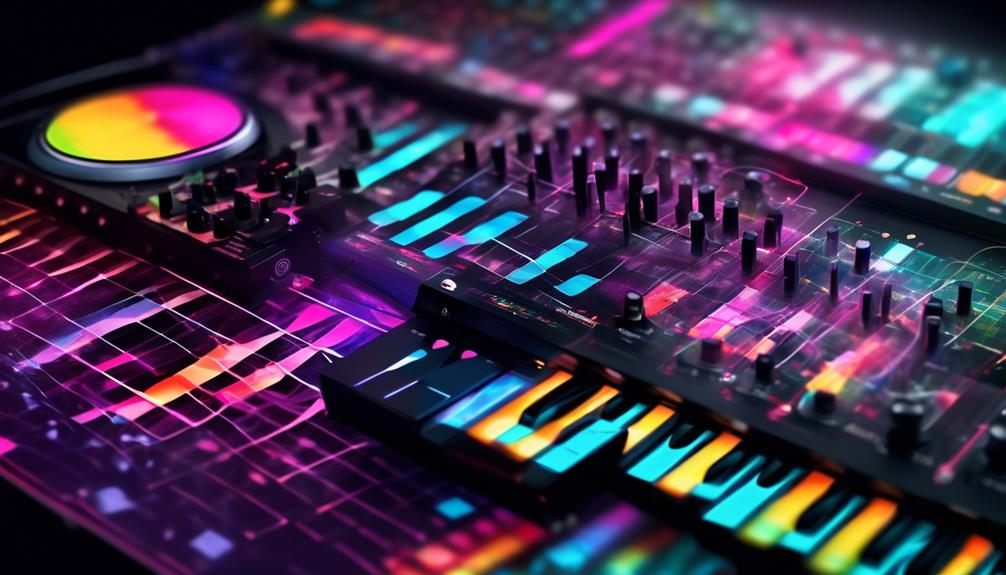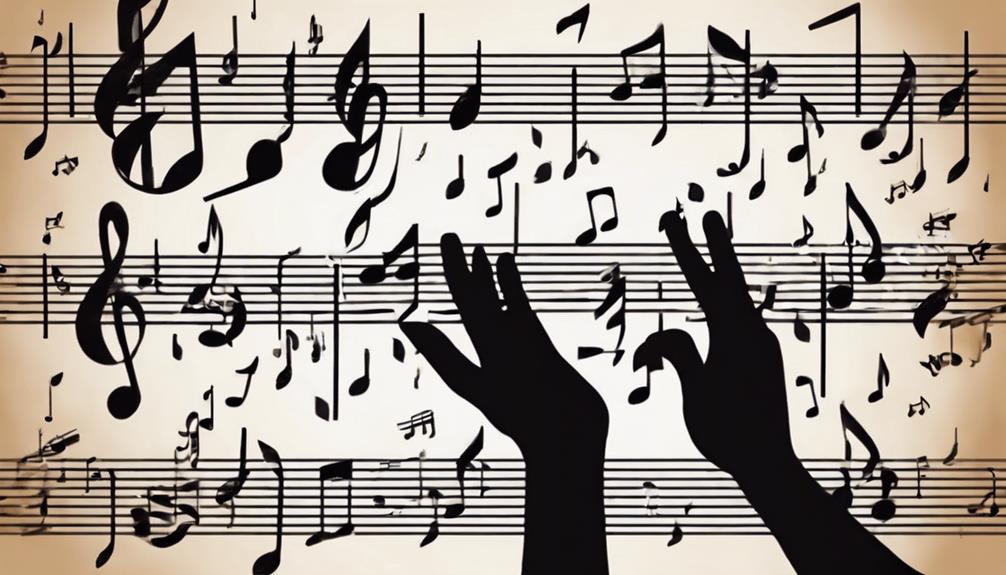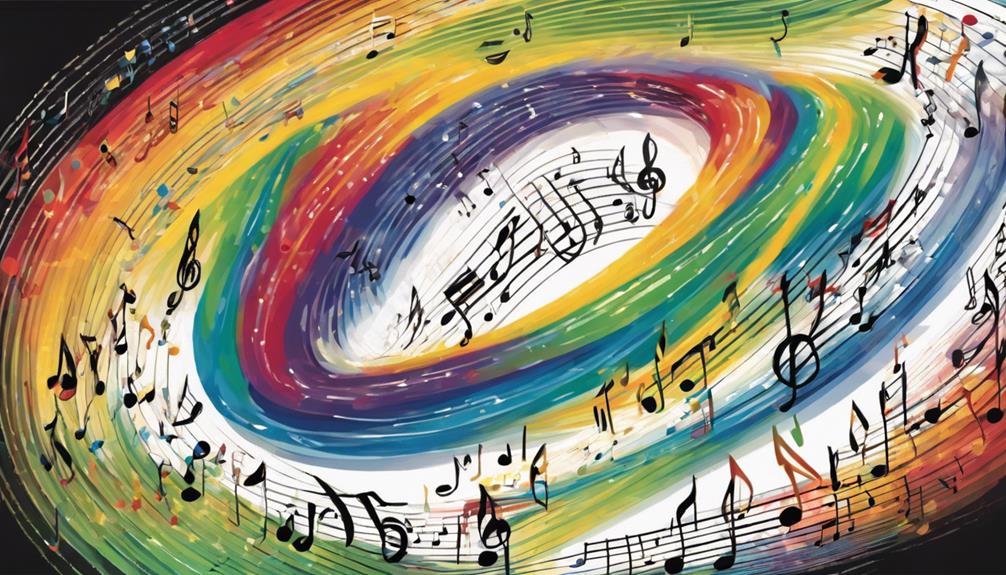No products in the cart.
Imagine you’re behind the decks, the crowd is pulsing with energy, and you’re about to transition into your next track. You’ve got the technical skills down, but there’s something missing – a seamless flow that could elevate your set from good to unforgettable.
As a beginner DJ, you might not have considered how a firm grasp of music theory can transform your performances. It’s not just about matching beats; understanding the structure of music – from the foundational beats and bars to the complexities of harmonic mixing – could be the key to unlocking that next level of mastery.
Let’s explore these six essential tips that will help you not only choose the right tracks but also blend them in ways that keep the dance floor engaged.
Stick around to discover how knowing just a bit more about the theory behind the music can set your sets apart from the rest.
Key Takeaways
- Counting beats and bars accurately is crucial for seamless transitions in DJing
- Keys define the mood and tone of a DJ set, and harmonic mixing techniques can elevate performances
- Grasping melodic structures and utilizing scales and rhythmic variations can help create captivating tunes
- Utilizing rests strategically can create tension and release in music.
Understanding Beats and Bars
To master the art of DJing, you’ll need to grasp the concept of beats and bars, as they form the fundamental structure upon which music is built and mixed. A beat is the pulse that you feel in a track, the one that makes you tap your feet. Typically, these beats are grouped in fours to create a bar. The first beat of every bar, known as the ‘one’, is your anchor, and it’s where you’ll often begin your count.
Counting beats and bars accurately is an essential skill. Not only does it allow you to understand the structure of a song, but it also enables you to anticipate changes and create those seamless transitions that keep the dance floor packed. You’ll need to become adept at recognizing the beat, whether it’s a thumping kick drum or a subtle hi-hat tap.
The importance of tempo and time signature in DJing can’t be overstated. These elements dictate how fast a track feels (its tempo) and how the beats are grouped (time signature). By mastering these concepts, you’ll be able to mix tracks of different genres and tempos, maintaining a coherent flow and keeping your audience engaged.
Always remember, it’s the precision in your craft that sets you apart.
Identifying Musical Notes
Diving into the realm of musical notes, you’ll discover that each pitch corresponds to a letter from A to G, forming the backbone of Western music notation. Recognizing note patterns is critical as you navigate the sonic landscape. This foundation allows you to anticipate the flow of a track, crucial for seamless transitions and creating engaging sets.
To effectively identify notes, you must understand their placement on the staff, which dictates pitch, and the shape of the note head, which indicates duration. Whole notes, half notes, quarter notes, and their respective variants guide the temporal aspect of your music selection and mixing.
Mastering sight reading techniques elevates your proficiency, enabling you to interpret and predict musical phrases with agility. This skill is particularly invaluable when working with new tracks or genres, ensuring you’re always ahead of the beat.
Additionally, ear training is indispensable; honing your ability to discern pitches by ear will complement your technical knowledge, allowing for intuitive and innovative performances.
Grasping Keys and Scales

Understanding the relationship between keys and scales is essential for crafting DJ sets that resonate with both melody and harmony. As you delve into the world of DJ music theory, remember these foundational concepts:
- Keys define the sonic territory: They set the mood and tone of your mix. Recognizing the importance of tempo and key matching in DJ sets ensures smooth transitions and a cohesive listening experience.
- Scales are the building blocks: By playing around with the white notes in a particular range, like the C major scale, you’re laying down a harmonious foundation for your tracks to flourish.
- Chords are your allies: Use them to bolster the melodies, adding depth and emotion.
Now, let’s talk innovation. When you’re comfortable with keys and scales, you’ll find creative ways to use key modulation to create tension and release in a DJ mix. This technique keeps your audience engaged, anticipating the next turn in your musical journey.
Mastering scales and their related keys not only empowers you to understand chord progressions but also to manipulate them. This knowledge is crucial for an expressive, dynamic set that tells a story and takes your audience on an unforgettable sonic adventure.
Building Basic Chords
Now that you’ve grasped keys and scales, let’s focus on constructing basic chords to enrich your mixes with harmonious layers. Building basic chords is a fundamental skill for creating the harmony that gives your music depth and emotion. These chords are typically constructed using the root note, the third, and the fifth from your chosen scale. A major chord gives a bright, full sound, while a minor chord imparts a more melancholic tone.
To innovatively shape the mood of your sets, dive into chord progressions. These are sequences of chords that create a sense of movement and development within your music. Start with simple progressions and learn how changes in chord sequences can dramatically alter the vibe of your mix.
Don’t just stick to the basics; explore triad variations by altering the third or the fifth, creating suspended or augmented chords that can add tension and release to your tracks. Experimenting with different chord inversions—playing the notes of a chord in a different order—can also add a fresh twist and keep your sound evolving.
Crafting Catchy Melodies


To kickstart your journey into crafting catchy melodies, you need to grasp the intricacies of melodic structures.
Harness your knowledge of scales to lay down a melody that’s not only technically sound but also captivating.
Don’t shy away from playing with rhythmic variations to give your tune a unique pulse that keeps listeners hooked.
Understanding Melodic Structures
Crafting a catchy melody requires you to weave together a sequence of notes that not only stick in the listener’s mind but also evoke an emotional response through the strategic use of tension and release.
Analyzing popular melodies and exploring melodic motifs will bolster your understanding of what resonates with audiences. Consider these steps to innovate your sound:
- Dissect Hit Songs: Break down chart-topping tracks to understand their melodic structures. Identify patterns that listeners love.
- Experiment with Scales: Utilize different scales as your playground for melody creation. This is where emotion stems from.
- Develop Motifs: Short, recurring patterns give your tracks identity. Build upon these to create complexity within simplicity.
Utilizing Scale Knowledge
Building on your exploration of melodic structures, harness the power of scales to infuse your melodies with the intended emotional impact. Delve into scale practice to develop your melodic intuition, allowing you to craft hooks that resonate with your audience.
Start by mastering the major and minor scales, as they’re foundational for creating mood and character in music.
When constructing melodies, consider the scale’s tonal center and experiment with stepwise motion versus leaps. This contrast gives your tunes a dynamic quality. Pay attention to the resolution of dissonant notes, aiming for a balance between tension and release that keeps listeners engaged.
Your melodic intuition grows with every track you dissect and every scale you internalize. This knowledge is your toolkit for innovation, shaping ear-catching melodies that define your unique sound as a DJ.
Implementing Rhythmic Variations
As you delve into crafting catchy melodies, consider how rhythmic variations can inject vitality and memorability into your music.
Here are three innovative ways to enhance your melodic creations:
- Exploring Syncopation: Shift the emphasis to off-beats. This unexpected accentuation keeps listeners on their toes and contributes to a groove that’s hard to forget.
- Vary Note Lengths: Mix quarter, eighth, sixteenth notes, and beyond. Contrasting long sustains with rapid-fire sequences creates a dynamic soundscape.
- Creating Tension with Rests and Pauses: Silence is your secret weapon. Intentional gaps can heighten anticipation and provide a satisfying release when the melody resumes.
Harnessing Harmonic Mixing


To master harmonic mixing, you’ll need to grasp key compatibility and how it shapes your transitions.
Start by using key detection software or applying your music theory knowledge to determine the keys of your tracks.
Then, familiarize yourself with the Camelot Wheel, a vital tool for quickly identifying harmonically compatible songs to enhance your set’s cohesion.
Understanding Key Compatibility
One can significantly elevate their DJ performances by mastering key compatibility, the art of blending tracks in harmonically matching keys for seamless transitions. This involves:
- Analyzing tonal relationships between tracks to ensure they complement each other.
- Utilizing harmonic mixing techniques to maintain the set’s energy and flow.
- Leveraging software tools to identify tracks that are harmonically compatible.
When you understand the intricacies of key compatibility, you’re not just mixing beats; you’re weaving a tapestry of sound that resonates on a deeper, more emotive level.
This innovative approach to DJing allows you to create sets that tell a story, sets that aren’t just heard but are felt by your audience. Embrace this technical artistry, and watch as your performances transform from standard to extraordinary.
Mastering the Camelot Wheel
Dive into the Camelot Wheel, a powerful tool for DJs to execute harmonic mixing with precision and ease. This ingenious system simplifies the complex relationships between musical keys, enabling you to blend tracks seamlessly. It’s all about maintaining a harmonious flow—essential when you’re perfecting your transition techniques.
| Emotion | Camelot Code |
|---|---|
| Euphoric | 8B |
| Reflective | 5A |
| Intense | 10A |
| Relaxed | 2B |
| Uplifting | 1B |
Understanding this system is paramount for innovative beat matching. Each mix becomes an exploration of musical landscapes, guiding your audience through peaks and valleys of auditory experience. Embrace this tool, and you’ll unlock a new dimension in your DJ sets, ensuring every transition is not just technically sound, but emotionally resonant.
Frequently Asked Questions
Do You Need to Know Music Theory to Be a Dj?
You don’t need music theory to DJ, but it sharpens your beat matching and turntable techniques, giving you an innovative edge in crafting groundbreaking mixes. It’s a tool, not a requirement.
What Should a Beginner DJ Learn?
You should learn beat matching and equipment familiarity. Practice syncing rhythms and explore your gear’s capabilities to innovate your sound and stay ahead in the dynamic DJ landscape.
How Do I Get Really Good at Dj?
To excel at DJing, you’ve got to master mixing techniques and become intimately familiar with your equipment. Push boundaries, innovate, and always refine your craft through practice and embracing new technology.
What Is the First Thing to Learn in Music Theory?
You’ll want to start with rhythm fundamentals, grasping beats and bars to set your musical foundation. Then, dive into scale basics to understand melodies and harmonic structures for innovative mixing.
Conclusion
Now that you’ve got the basics down, keep practicing. Internalize beats and bars to maintain flawless rhythm. Recognize notes to communicate in the language of music. Master keys and scales for a diverse mix.
Build chords that resonate, and craft melodies that captivate. Finally, harmonize your mixing to elevate your DJ prowess. Your dedication to music theory sharpens your edge, enabling you to create sets that truly resonate with your audience.
Keep spinning; keep learning.




